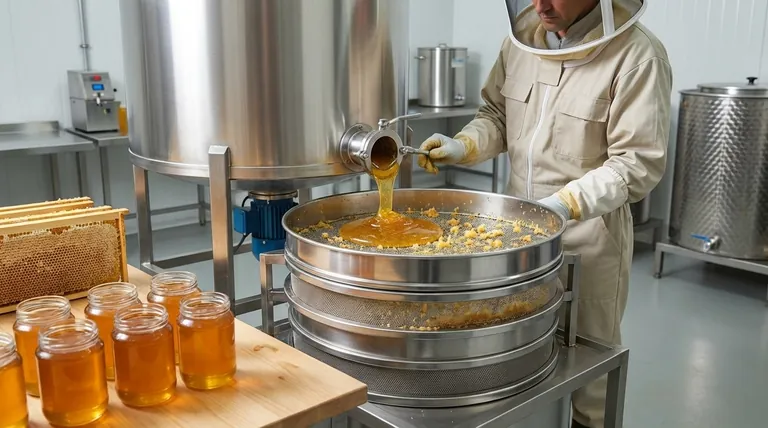At its core, a honey filter is a purification tool. Its primary role is to mechanically remove physical impurities—such as wax particles, bee parts, and hive debris—that are naturally present after extraction. This process utilizes a series of fine screens, often assisted by gentle heat and pressure, to ensure the final product is clean, safe, and visually appealing for packaging and consumption.
The central challenge in honey processing is balancing purity with preservation. A honey filter is the critical instrument for removing unwanted physical debris, but the intensity of the filtration process directly determines whether you produce a crystal-clear liquid or retain the pollen and enzymes characteristic of raw honey.

How Honey Filtration Achieves Purity
The process of filtering honey is a physical one, designed to separate the liquid honey from solid contaminants that are collected during the harvesting and extraction process.
The Mechanical Separation Process
A honey filter works like a sieve. It uses a fine mesh screen, typically made of nylon or stainless steel, to physically block particles that are larger than the openings in the mesh while allowing the liquid honey to pass through.
Systems can range from a simple single screen to multi-stage filters that use progressively finer meshes to remove smaller and smaller particles in sequence.
Key Impurities Targeted for Removal
During extraction, various bits of debris from the hive inevitably mix with the honey. Filtration is specifically designed to remove these elements.
Common targets include bits of wax cappings, fragments of propolis, parts of bees (such as wings or legs), and splinters from the wooden frames.
The Role of Gentle Heat and Pressure
Honey is highly viscous, meaning it is thick and flows slowly. To improve efficiency, processors often apply gentle heat.
Warming the honey slightly lowers its viscosity, allowing it to pass through the fine filter screens more easily and quickly. Gentle pressure, either from a pump or gravity, further assists this movement, ensuring a consistent flow.
Understanding the Trade-offs
While filtration is essential for creating a commercially acceptable product, the method and intensity of the process involve important trade-offs that affect the final character of the honey.
Purity vs. Pollen Content
The term "purity" in this context refers to the absence of physical debris. However, aggressive filtration can also remove microscopic elements that many consumers value, most notably pollen grains.
Honey that is heavily filtered to be perfectly clear will have a lower pollen count than honey that is only lightly strained. Many consider pollen to be a beneficial component of raw honey.
The Impact of Mesh Size
The fineness of the filter (measured in microns) is the determining factor.
A coarse filter (around 400-600 microns) will remove large debris like wax and bee parts while leaving most pollen intact. A fine filter (under 100 microns) will produce exceptionally clear honey but will also remove nearly all of the pollen.
The Risk of Excessive Heat
While gentle warming is beneficial for filtration, excessive heat can be detrimental. Overheating honey can destroy valuable enzymes and degrade its delicate flavor and aroma profile.
Proper filtration, therefore, requires careful temperature control to preserve the honey's natural integrity.
Making the Right Choice for Your Goal
Your approach to filtration should align directly with the intended purpose of your honey and the expectations of your consumer.
- If your primary focus is producing "raw" honey for personal use: A simple, coarse straining to remove only the largest pieces of wax and debris is sufficient.
- If your primary focus is selling at a farmers market: A medium-level filtration that ensures good clarity without removing all pollen often strikes the perfect balance between visual appeal and natural quality.
- If your primary focus is commercial retail: Fine filtration is generally required to achieve the crystal clarity, consistency, and long shelf life (as removing particles slows crystallization) that most supermarket consumers expect.
Ultimately, understanding filtration empowers you to produce honey that perfectly aligns with your standards for both purity and character.
Summary Table:
| Filtration Goal | Recommended Filter Type | Key Outcome |
|---|---|---|
| Raw Honey / Personal Use | Coarse Strainer (400-600 microns) | Removes large debris, preserves pollen & enzymes |
| Farmers' Market Sales | Medium Filtration | Good clarity while retaining natural qualities |
| Commercial Retail | Fine Filter (<100 microns) | Crystal clarity, slow crystallization, long shelf life |
Ready to scale your honey production with the right filtration equipment?
HONESTBEE supplies commercial apiaries and beekeeping equipment distributors with high-quality, durable honey filters and processing systems. Whether you need a simple strainer for raw honey or a multi-stage system for commercial clarity, we have the wholesale solutions to meet your purity and volume goals.
Contact our experts today to discuss the best filtration setup for your operation and request a wholesale quote.
Visual Guide

Related Products
- HONESTBEE 72 Frame Industrial Electric Honey Extractor for Beekeeping
- Honey Concentrating Vacuum Heating Thickening Machine Dehumidifier for Honey
- Plastic Hand Crank 2 Frame Honey Extractor Low Price
- Professional Thermostatic Conical Honey Melter
- High Quality Honey Dehumidifier Dryer Thickening Machine for Beekeeping
People Also Ask
- Why do beekeepers have to lift a lot of weight at the end of a growing season? The Reward of a Heavy Harvest
- What are the advantages of automated honey extractors in terms of time efficiency? Boost Your Harvest Speed
- What are the two common types of honey extractors? Choose the Right Extractor for Your Apiary
- What should a beekeeper do after extracting honey from supers? A Guide to Harvest Management
- Why is preserving honeycomb integrity important, and how do automated extractors help? Boost Hive Health & Honey Yields



















